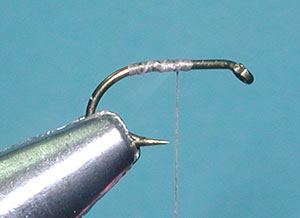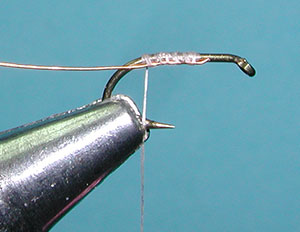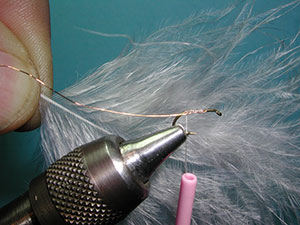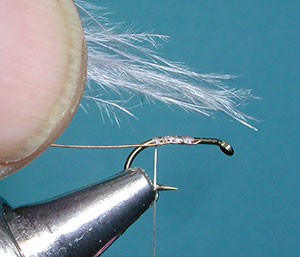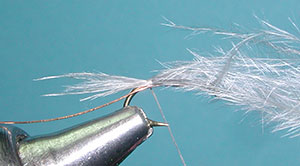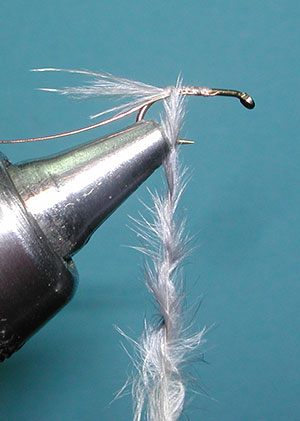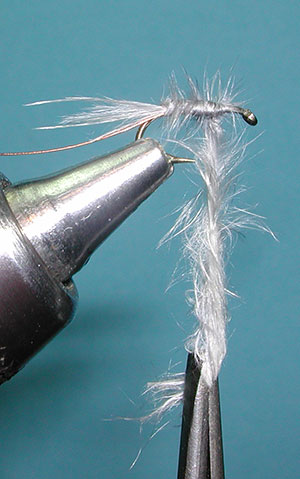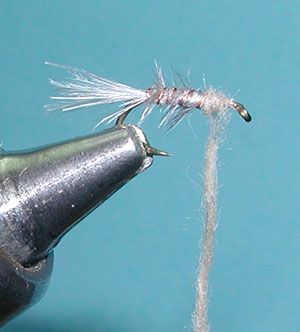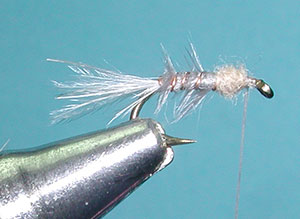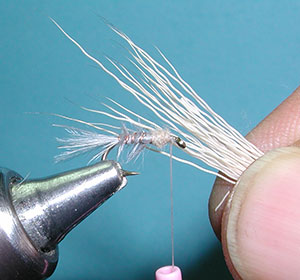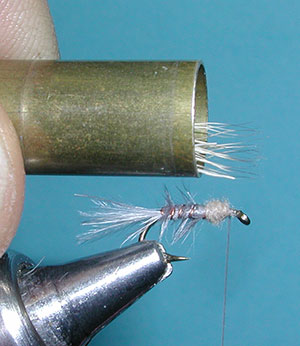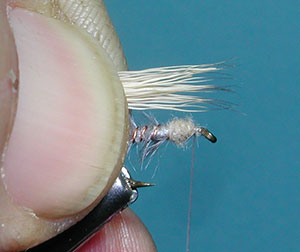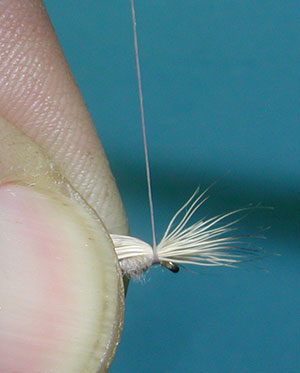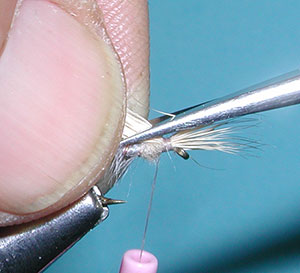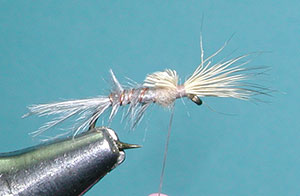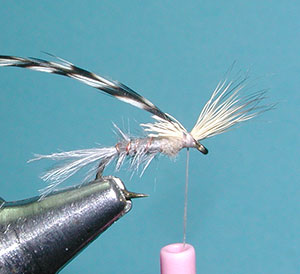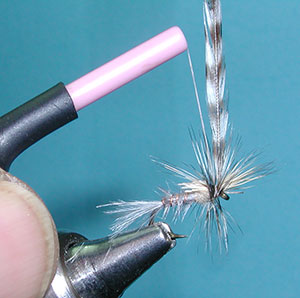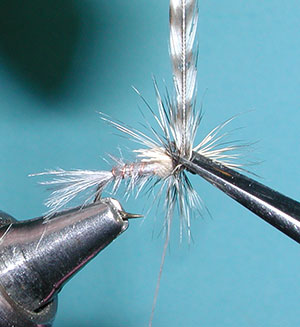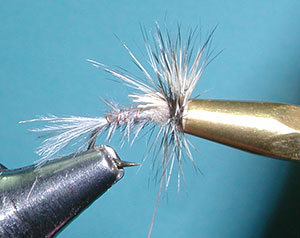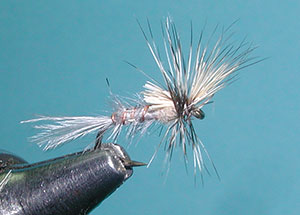Quigley Cripple

Quigley Cripple, Callibaetis
Tying Instructions
| Materials
to Order Material, click the link |
|
|---|---|
| Hook | TMC 100 #14-16 |
| Thread | Uni-thread Gray 8/0 |
| Body | Gray Marabou |
| Thorax | Tan Superfine Dubbing |
| Ribbing | Small Copper Wire |
| Tail | Gray Marabou tips |
| Wing | Natural Comparadun Hair |
| Hackle | Natural Grizzly |
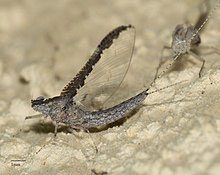
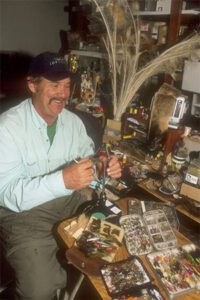
Bob Quigley
Quigley Cripple
Cripples represent mayflies that are just emerging or got stuck in it’s shuck. Bob Quigley came up with his Quigley Cripple pattern in 1978 while he was fishing Fall River in Northern California. Bob’s Cripple patterns are distinguished with a forward wing, usually of Deer or Elk Hair, extending over the eye of the hook and the butt of the wing trimmed in line with a dubbed thorax to represent an emerging dun. The rear portion of tail, usually Marabou tips, and abdomen is tied to represent the trailing shuck as the mayfly has pulled free from it’s nymphal body.
Hook Choice
The intent is to have the top half of the fly reside above water while the bottom half hangs within the water column. Initially, Bob tied this pattern to a standard Dry Fly hook such as a TMC 100 or 101. However, curved hooks such as a TMC 2312 or 2302 were used because they gave the fly a more natural posture. Some will even tie this pattern onto a Scud type hook such as a TMC 2487.
Bob passed away on June 12, 2012 from cancer and will be missed by many. He designed other innovative patterns such as the Hackle Stacker, Flag Dun, and Loop Wing Paradun but the Quigley Cripple will remain his defining pattern utilizing hair for the wing case and a protruding tuft.
Diverse Materials
Since the pattern can be devised for a wide range of Mayflies and Caddis, the types of materials one uses is also widely diverse. The tail is usually made up of Marabou tips since the material is thick with barbules. Marabou Plumes also provide heavily barbed flues and work well for this pattern, just snip off the number of flues you need from the quill stem. At times, Antron Yarn or Z-lon are substituted to give the fly more durability and you could use Ostrich Herl, Emu, Pheasant Tail fibers or Wood Duck Fibers for a better imitation.
Body Materials
A rib is generally used when the abdomen is made of herl or marabou, such as a gold wire of medium gauge for sizes #12-14 or a small gauge for sizes #16 and smaller. Marabou was preferred by Bob to give a sense of gills to the fly within the abdomen. This is a good material for sizes #14 or larger. For smaller mayflies, a thinner body made of Turkey or Goose biots, Pheasant Tail fibers, or stripped Hackle quills can be a better choice. The thorax is usually made of Antron dubbing according to the color of the mayfly. This is particularly good to use on the smaller sizes.
Deer Hair
For larger sizes and large mayflies, Bob also used spun Deer Hair or foam to provide better floatation. The Wing is that portion of the adult that is free to maneuver but is trapped. Usually the wing will be natural or dyed Deer Hair but CDC and Elk Hair have also been used. It’s important to go light on the number of hairs used for the wing as to anchor the hairs securely to the hook shank.
The hackle is usually a natural or dyed Grizzly. Bob preferred to use 3-4 turns of hackle on flies used within slow water situations and 6-8 turns for fast water. Whiting 100’s are sized within the range of most cripple patterns and offer a wide color selection. For the Hexagenia pattern, you may need a saddle hackle to get the larger sizes in 8 and 10.
Fluttering Cripple
Bob would split the wing with a figure eight wrap so that the wings are at a 45 degree angle to the shank. When tied this way it is known as a Fluttering Cripple. As the season progresses go to smaller and darker pattern colors. Apply floatant only to the wing portion of this fly in order for the body to become subsurface. You can also try to use rubberlegs to provide more action to the fly.
Other Variations
An excellent variation of the Quigley Cripple is the Last Chance Cripple designed by Rene and Bonnie Harrop of St. Anthony, Idaho. The wing is made up of 2 CDC feathers and the body is a goose biot. The tail uses three Wood Duck strands under a small amount of Antron Sparkle dubbing. The Last Chance Cripple is part of the Harrop’s mayfly series which include CDC Biot Thorax, CDC Biot Dun, CDC Captive Dun , CDC Biot Emerger, and CDC Para-spinner.
Variations
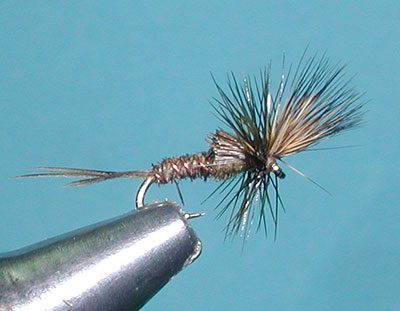
Baetis Quigley Cripple
| Hook | TMC 100, #16-20 |
| Thread | Uni-thread Brown 8/0 |
| Body | Natural Pheasant Tail Fibers |
| Thorax | BWO Superfine |
| Ribbing | Small Copper Wire |
| Tail | Natural Pheasant Tail Fibers |
| Wing | Natural Comparadun Hair |
| Hackle | Olive Grizzly Hackle |
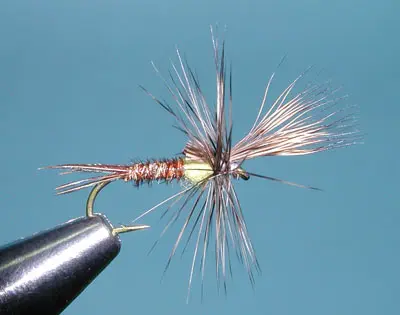
PMD Quigley Cripple
| Hook | TMC 100, #14-18 |
| Thread | Uni Thread 8/0 Gray |
| Body | Natural Pheasant Tail Fibers |
| Thorax | PMD Superfine |
| Ribbing | Small Gold Wire |
| Tail | Natural Pheasant Tail Fibers |
| Wing | Natural Comparadun Hair |
| Hackle | Med. Dun Hackle |

Green Drake Quigley Cripple
| Hook | TMC 2487, #10-14 |
| Thread | Danville Olive 6/0 |
| Body | Brown Olive Marabou |
| Thorax | Medium Olive Antron |
| Ribbing | Single strand Yellow Uni Yarn |
| Tail | Brown Olive Marabou tips |
| Wing | Natural Comparadun Hair |
| Hackle | Pale Yellow dyed Grizzly Hackle |

Hexagenia Quigley Cripple
| Hook | TMC 2302, #8-10 |
| Thread | Danville Yellow 6/0 |
| Body | Gray Marabou |
| Thorax | Yellow Dyed Deer Hair |
| Ribbing | Single strand Yellow Uni Yarn |
| Tail | 3 Natural UV2 Emu strands |
| Wing | Yellow Dyed Deer Hair |
| Hackle | Golden Olive dyed Grizzly Hackle |
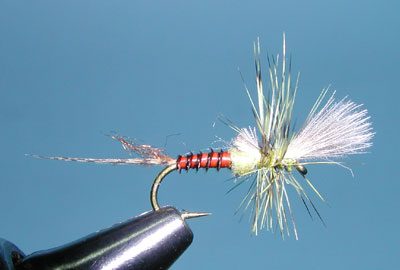
Last Chance Cripple, PMD
| Hook | TMC 100, #16-18 |
| Thread | Uni-Thread Yellow 8/0 |
| Body | Brown Goose Biot |
| Thorax | PMD Superfine |
| Tail | 3 Strands Dyed Mallard Flank, Woodduck |
| Shuck | Rust Antron Dubbing |
| Wing | 2 Light Dun CDC feathers |
| Hackle | Yellow Dyed Grizzly Hackle |

Last Chance Cripple, Baetis
| Hook | TMC 100, #18-20 |
| Thread | Uni-Thread Olive 8/0 |
| Body | Brown Goose Biot |
| Thorax | Gray/Olive Superfine |
| Shuck | Rust/Med. Olive Antron Dubbing Blend |
| Tail | 3 Strands Dyed Mallard Flank, Woodduck |
| Wing | 2 Medium Dun CDC feathers |
| Hackle | Dun Dyed Grizzly Hackle |
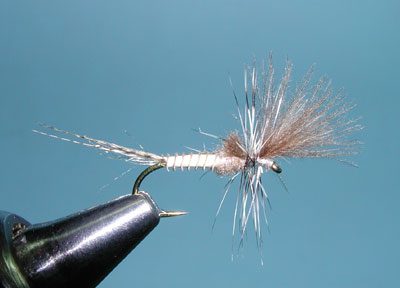
Last Chance Cripple, Callibaetis
| Hook | TMC 100, #14-16 |
| Thread | Uni-Thread Gray 8/0 |
| Body | Turkey Biot, dyed Callibaetis |
| Thorax | Callibaetis Superfine |
| Shuck | Ginger Z-lon |
| Tail | 3 Strands Dyed Mallard Flank, Woodduck |
| Wing | 2 Medium Dun CDC feathers |
| Hackle | Natural Grizzly Hackle |

